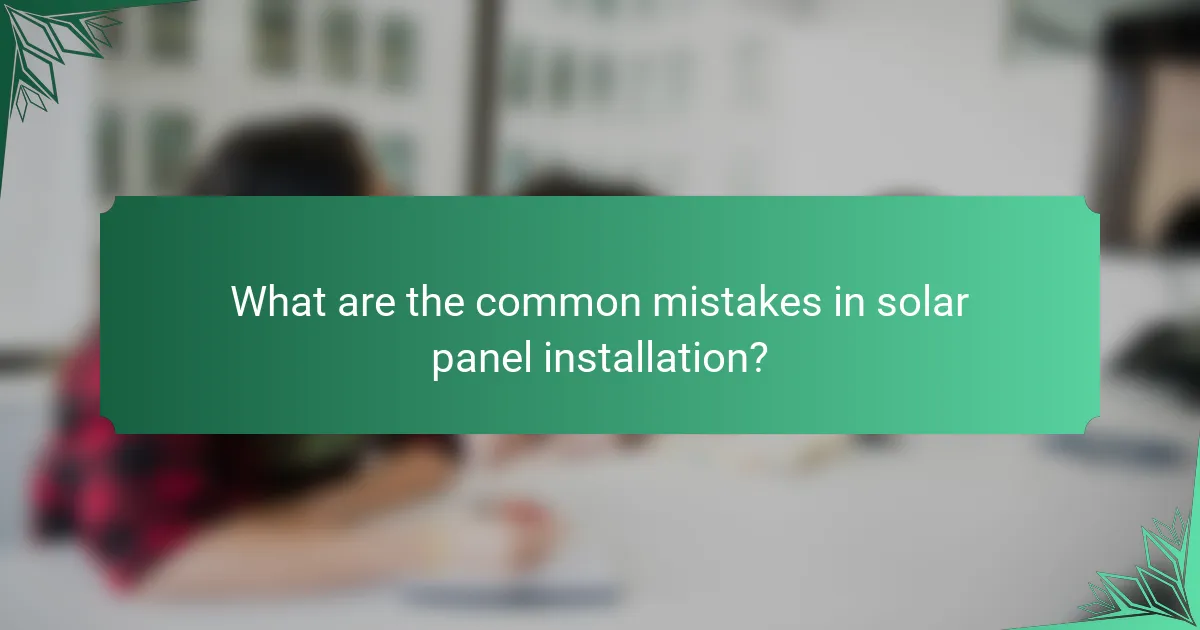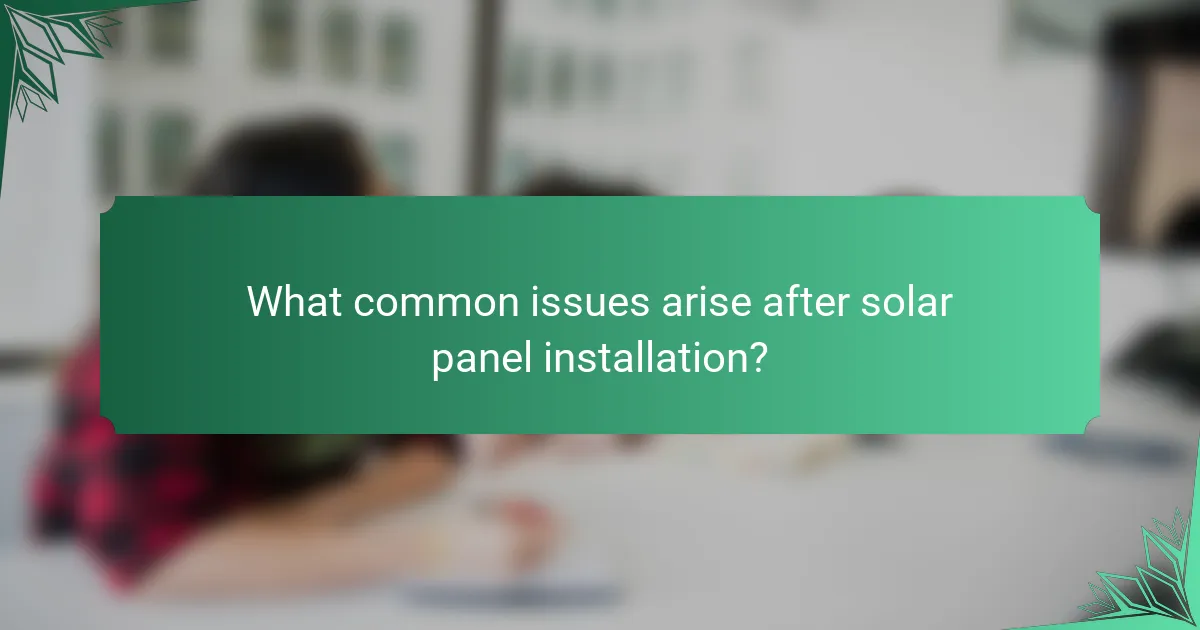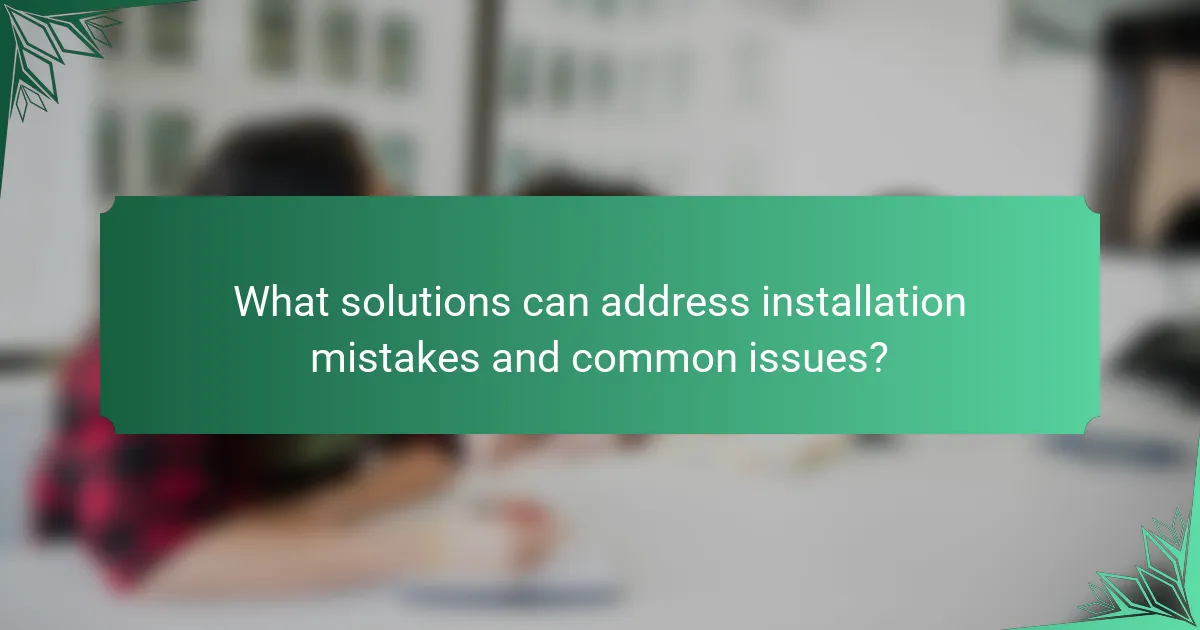
What are the common mistakes in solar panel installation?
Common mistakes in solar panel installation include improper placement, inadequate structural support, and incorrect electrical connections. Improper placement can lead to reduced efficiency. Panels should be positioned to maximize sun exposure. Inadequate structural support may cause panels to become loose or damaged. Proper mounting systems must be used to ensure stability. Incorrect electrical connections can lead to system failures or safety hazards. Following manufacturer guidelines and local codes is crucial for safe installation. Regular inspections can help identify and correct these common issues.
Why is proper planning crucial for solar panel installation?
Proper planning is crucial for solar panel installation to ensure efficiency and effectiveness. It allows for accurate assessment of energy needs and optimal system design. Planning helps identify the best location for panel placement, maximizing sunlight exposure. It also aids in budgeting and resource allocation, preventing unexpected costs. A well-thought-out plan can reduce installation time and improve safety. Furthermore, proper planning ensures compliance with local regulations and permits. Studies show that thorough planning can increase system performance by up to 30%.
What steps should be taken during the planning phase?
Identify the project scope and objectives. This establishes what the solar panel installation aims to achieve. Conduct a site assessment to evaluate the location’s solar potential and structural integrity. This helps determine the best placement for the panels. Research local regulations and permits required for installation. Compliance ensures that the project adheres to legal standards. Create a budget that includes all costs associated with installation. This aids in financial planning and resource allocation. Develop a timeline for the installation process. A clear schedule helps coordinate tasks and manage expectations. Engage with qualified solar installation professionals for expert advice. Their experience can help avoid common mistakes. Finally, review and finalize the installation plan before execution. This ensures all aspects are considered and aligned with project goals.
How does site assessment impact installation success?
Site assessment significantly impacts installation success by evaluating the suitability of a location for solar panel systems. It identifies optimal sunlight exposure, which is crucial for energy efficiency. Proper assessment can reveal potential shading from trees or buildings that may hinder performance. Additionally, it assesses structural integrity to ensure the installation can support the solar panels. This evaluation helps in selecting appropriate equipment and installation techniques. Research indicates that proper site assessments can increase energy production by up to 30%. Accurate assessments lead to informed decisions, reducing the risk of costly installation errors.
What installation errors frequently occur?
Common installation errors in solar panel setups include improper roof mounting, incorrect wiring, and inadequate system sizing. Improper roof mounting can lead to leaks and structural damage. Incorrect wiring may cause system failures or safety hazards. Inadequate system sizing results in insufficient energy production. These errors often stem from lack of experience or insufficient planning. According to the National Renewable Energy Laboratory, proper installation practices significantly enhance system performance and longevity.
How can improper mounting affect solar panel performance?
Improper mounting can significantly reduce solar panel performance. When panels are not securely attached, they can shift or tilt. This misalignment leads to decreased sunlight exposure. Panels may also experience overheating if airflow is restricted. Poor mounting can cause physical damage during high winds or storms. Research indicates that optimal angle and orientation improve efficiency by up to 25%. Therefore, correct mounting is crucial for maximizing energy production.
What are the risks of incorrect wiring during installation?
Incorrect wiring during solar panel installation can lead to several serious risks. These include electrical fires, which can occur due to short circuits caused by improper connections. Incorrect wiring can also result in equipment damage, leading to costly repairs or replacements. Additionally, it can cause system inefficiency, reducing the energy output of the solar panels. In some cases, incorrect wiring may create safety hazards for installers and homeowners. According to the National Fire Protection Association, electrical failures or malfunctions are a leading cause of home fires. Ensuring proper wiring is crucial to mitigate these risks and ensure safe and efficient operation of solar energy systems.
How can choosing the wrong materials lead to issues?
Choosing the wrong materials can lead to significant issues in solar panel installation. Inadequate materials may result in reduced energy efficiency. For example, subpar solar panels can underperform, generating less electricity. Poor-quality mounting systems can lead to structural failures. This may cause panels to detach or become misaligned. Additionally, using inappropriate wiring can increase the risk of electrical failures. These failures can lead to costly repairs and safety hazards. Studies show that improper material selection can decrease system lifespan by up to 20%. Thus, careful material choice is crucial for optimal solar panel performance and longevity.
What types of solar panels are best for different environments?
Monocrystalline solar panels are best for areas with limited space and high efficiency needs. They perform well in low-light conditions and have a lifespan of 25 years or more. Polycrystalline solar panels are suitable for larger spaces with lower efficiency requirements. They are cost-effective but occupy more space. Thin-film solar panels are ideal for flexible applications and can perform better in high temperatures. They are lightweight and can be integrated into various surfaces. Each type of solar panel has unique attributes that cater to different environmental conditions.
How does the choice of inverter impact system efficiency?
The choice of inverter significantly impacts system efficiency. Inverters convert the direct current (DC) generated by solar panels into alternating current (AC) for home use. Higher quality inverters typically have better conversion efficiencies, which can exceed 98%. This means less energy is lost during the conversion process.
For example, a standard inverter may lose around 2-4% of energy, while a high-efficiency inverter can minimize these losses. Additionally, the inverter’s ability to handle varying loads and its performance in different temperature conditions also affect overall efficiency.
Inverters with advanced features, such as maximum power point tracking (MPPT), optimize energy harvest from solar panels, further enhancing system performance. A study by the National Renewable Energy Laboratory found that using high-efficiency inverters can increase overall system output by 10-20%. Thus, selecting the right inverter is crucial for maximizing solar energy utilization.

What common issues arise after solar panel installation?
Common issues after solar panel installation include inverter problems, shading, and wiring issues. Inverter problems can lead to system downtime. Shading from trees or buildings can reduce efficiency. Wiring issues may cause electrical faults or safety hazards. Poor installation can lead to leaks or structural damage. Monitoring systems might fail, leading to undetected performance issues. Regular maintenance is essential to address these problems effectively.
What are the signs of poor solar panel performance?
Signs of poor solar panel performance include reduced energy output and frequent system shutdowns. If solar panels are producing significantly less energy than expected, this indicates an issue. Additionally, shading from nearby trees or buildings can hinder performance. Dirt and debris accumulation on the panels can also reduce efficiency. Inverter errors or alerts are another sign of potential problems. If the panels show physical damage, such as cracks or discoloration, performance may be compromised. Regular monitoring can help identify these issues early.
How can shading affect energy production?
Shading significantly reduces energy production in solar panels. When a solar panel is shaded, its efficiency decreases because less sunlight reaches the photovoltaic cells. Even partial shading can lead to a substantial drop in power output. For instance, a study by the National Renewable Energy Laboratory found that shading one panel can reduce the entire system’s output by up to 80%. This occurs because solar panels are typically connected in series. If one panel is shaded, it can limit the current flowing through the entire string of panels. Therefore, proper placement and avoiding shading from trees, buildings, or other objects are crucial for maximizing energy production.
What maintenance issues should be monitored regularly?
Regular maintenance issues for solar panel systems include checking for dirt and debris accumulation, inspecting wiring for damage, and monitoring inverter performance. Dirt and debris can block sunlight, reducing efficiency. Damaged wiring may cause safety hazards and system failures. Inverter performance should be monitored to ensure optimal energy conversion. Regular inspections can prevent costly repairs and ensure longevity. Studies indicate that routine maintenance can improve solar panel efficiency by up to 20%.
Why is monitoring system performance important?
Monitoring system performance is important because it ensures optimal energy production from solar panels. Regular monitoring identifies issues like shading, dirt accumulation, or equipment malfunction. These problems can significantly reduce efficiency and energy output. For instance, a study showed that unmonitored systems can lose up to 20% of their potential energy due to such issues. By tracking performance metrics, users can take timely action to maintain system efficiency. This proactive approach maximizes return on investment and enhances the longevity of the solar installation.
How can performance monitoring tools help detect problems?
Performance monitoring tools can identify problems in solar panel systems by tracking real-time performance metrics. These tools measure energy output, efficiency, and system health. They can detect anomalies such as drops in energy production. For instance, a significant decrease in output may indicate shading or malfunctioning components. Alerts can be set up to notify users of these issues immediately. Historical data analysis allows for trend identification, which helps in predicting potential failures. According to a study by the National Renewable Energy Laboratory, effective performance monitoring can improve energy yield by up to 10%. This proactive approach ensures timely maintenance and optimal system performance.
What metrics should be tracked for optimal performance?
Key metrics to track for optimal performance of solar panel installations include energy production, system efficiency, and maintenance costs. Energy production measures the amount of electricity generated, typically in kilowatt-hours (kWh). System efficiency indicates how effectively the solar panels convert sunlight into electricity, often expressed as a percentage. Maintenance costs reflect the financial investment required for upkeep and repairs.
Tracking energy production helps identify underperformance issues. For instance, a significant drop in kWh output could signal shading or equipment failure. Monitoring system efficiency allows for comparisons against industry benchmarks, typically around 15-20% for residential systems. Regular assessment of maintenance costs ensures budget adherence and can highlight potential savings through preventive measures. Collectively, these metrics provide a comprehensive view of solar panel performance and facilitate informed decision-making for enhancements.

What solutions can address installation mistakes and common issues?
Solutions to address installation mistakes and common issues include thorough planning and proper training. Conducting a detailed site assessment can identify potential challenges. Using quality materials ensures durability and performance. Following manufacturer guidelines is crucial for correct installation. Regular inspections during the installation process help catch mistakes early. Engaging experienced professionals reduces the likelihood of errors. Implementing a comprehensive maintenance plan addresses issues post-installation. Research shows that proper training can reduce installation errors by up to 30%.
How can homeowners rectify installation mistakes?
Homeowners can rectify installation mistakes by assessing the error and determining the necessary corrections. They should first identify the specific issue, such as misalignment or improper wiring. Next, they can consult the installation manual for guidance on proper procedures. If the mistake is beyond their expertise, hiring a certified technician is advisable. The technician can provide professional insight and ensure compliance with safety standards. Homeowners should document the mistake and the steps taken to correct it for future reference. This process helps prevent similar errors during future installations.
What steps can be taken to fix improper mounting?
To fix improper mounting of solar panels, first, assess the current installation. Check for misalignment and ensure panels are level. If panels are not securely fastened, re-tighten or replace mounting hardware. Inspect the mounting brackets for damage and replace if necessary. Adjust the tilt angle to optimize solar exposure based on location. Ensure that all electrical connections are secure and properly insulated. Finally, conduct a thorough inspection after adjustments to confirm stability and performance. Proper mounting is crucial for efficiency and longevity of solar installations.
How can wiring issues be safely resolved?
Wiring issues can be safely resolved by turning off the power supply before any work begins. This prevents electrical shocks and ensures safety. Next, inspect the wiring for visible damage, such as fraying or corrosion. Replace any damaged wires immediately to avoid further complications. Use appropriate tools, such as wire strippers and connectors, to ensure secure connections. Additionally, follow local electrical codes and guidelines for installation. If unsure, consult a licensed electrician for professional assistance. This approach minimizes risks and ensures compliance with safety standards.
What preventive measures can be implemented?
Preventive measures for solar panel installation include proper site assessment, quality equipment selection, and professional installation. Conducting a thorough site assessment ensures adequate sunlight exposure and avoids shading issues. Selecting high-quality solar panels and inverters minimizes the risk of early failure. Hiring certified professionals for installation reduces mistakes related to wiring and mounting. Regular maintenance checks help identify potential issues early. Following manufacturer guidelines during installation ensures compliance with safety standards. These measures collectively enhance the efficiency and longevity of solar panel systems.
How can regular maintenance improve solar panel longevity?
Regular maintenance can significantly improve solar panel longevity by ensuring optimal performance and preventing damage. Routine cleaning removes dirt, debris, and dust that can block sunlight. This enhances energy efficiency and output. Regular inspections identify signs of wear or damage early. Addressing issues promptly prevents more extensive repairs later. Additionally, maintaining connections and wiring reduces the risk of electrical failures. Studies indicate that well-maintained solar panels can last 25 years or more. Regular maintenance ultimately maximizes the return on investment for solar energy systems.
What best practices should be followed during installation?
Ensure proper site assessment before installation. This involves evaluating the roof’s condition and orientation. Check for shading from nearby trees or buildings. Use appropriate mounting hardware for the roof type. Follow manufacturer guidelines for electrical connections. Verify local building codes and regulations. Engage certified professionals for installation tasks. Conduct a thorough inspection post-installation to ensure functionality. These practices enhance efficiency and longevity of solar panels.
What are the best troubleshooting tips for solar panel systems?
Check the inverter for error codes. Error codes indicate specific issues needing attention. Ensure the solar panels are clean and free of debris. Dirt can significantly reduce efficiency. Inspect the wiring for any visible damage or loose connections. Damaged wires can disrupt power flow. Verify that the solar panels are receiving adequate sunlight. Shade from trees or buildings can hinder performance. Monitor the system’s performance regularly through a monitoring app or device. This helps detect any drops in energy production. Consult the manufacturer’s manual for specific troubleshooting steps. Manuals often provide tailored solutions for common problems. If issues persist, contact a professional for further diagnosis. Professional help ensures safe and effective resolution of complex issues.
How can homeowners identify and solve common performance problems?
Homeowners can identify and solve common performance problems by regularly monitoring their solar panel system’s output. They should compare the energy production against expected performance metrics. If the output is significantly lower, it may indicate issues such as shading, dirt accumulation, or equipment failure.
Homeowners can inspect panels for physical damage or obstructions. Cleaning panels can improve efficiency if dirt is present. Additionally, checking the inverter for error codes can help identify technical issues.
Regular maintenance and professional inspections can also prevent performance problems. According to the U.S. Department of Energy, proper maintenance can enhance the lifespan and efficiency of solar systems.
What resources are available for further assistance with solar panel issues?
Resources for further assistance with solar panel issues include manufacturer support, local solar installers, and online forums. Manufacturer support provides specific guidance related to their products. Local solar installers can offer troubleshooting and repair services. Online forums, such as SolarPanelTalk, allow users to share experiences and solutions. Additionally, government websites often provide information on incentives and best practices. These resources help users address and resolve solar panel issues effectively.
The main entity of this article is solar panel installation, specifically focusing on common mistakes and issues that can arise during the process. Key topics include improper placement, inadequate structural support, incorrect electrical connections, and the importance of proper planning and site assessment. The article outlines steps to avoid installation errors, such as ensuring proper mounting and wiring, selecting quality materials, and conducting regular maintenance. Additionally, it provides solutions for rectifying mistakes and emphasizes the significance of monitoring system performance to enhance efficiency and longevity.